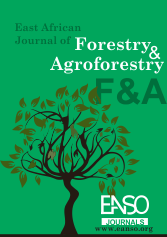Economic Analysis of Integrated Harvesting Relative to Conventional Harvesting on a Pinus patula Stand in Tanzania
Abstract
The conversion of a standing tree into a usable product is a very important activity and studies have shown that it is highly affected by the conversion costs which are associated with the whole plan (harvesting and processing). The economic aspects of forest harvesting are multifaceted and require careful consideration. Two harvesting systems were compared; first, Conventional Harvesting (CH) in this study means harvesting and processing of logs where only large diameter parts of the trees are utilized and mostly the small diameter parts are discarded causing loss of resources. Second, integrated harvesting (IH) in this study means the harvesting and processing of logs which are sorted according to end use allowing maximum utilization of the wood to the smallest diameter parts. This study aimed to determine the overall economics of forest conversion on tree felling and processing systems, specifically to determine the costs and revenue associated with IH and CH, with the factors influencing the choice of a felling and processing system. A study was done at FWITIC, a processing industry in the southern highlands, and data was collected through key informant interviews. The findings indicate higher total costs with IH ($2379) than CH ($1544), but also lower unit costs (84.37 US$/m3 for IH) and (100.3 US$/m3 for CH). The costs are topped by the revenue generated from each harvesting system of 177.222 US$/m3 for IH compared to 128.3 US$/m3 for CH, giving a benefit of 28.2 US$/m3 with CH and 92.84 US$/m3. The costs, benefits and time taken during the harvesting operations inform more on the influence on the selection of a harvesting and processing system
Downloads
References
Buchholz, T., Keeton, W.S., & Gunn, J.S. (2019). Economics of integrated harvests with biomass for energy in non-industrial forests in the northeastern US forest Economics of integrated harvests with biomass for energy in.
Canuel, C.M., Thiffault, E., & Thiffault, N. (2022). An empirical financial analysis of integrating biomass procurement in sawtimber and pulpwood harvesting in eastern Canada. Canadian Journal of Forest Research 52(6): 920–939.
Cho, M., Choi, Y., Oh, J., Mun, H., & Han, S. (2022). Comparison of harvesting productivity, cost and residual stand damages between single-tree selection thinning and mechanized line thinning using a small-scale grapple-saw. Forest Science and Technology 18(2): 45–55.
Dionisio, L. F. S., Costa, L. F., Milhomem, C. A., & Schwartz, G. (2021). Costs of semi-mechanized forest harvest of Tectona grandis L. F. in the Brazilian Amazon. Colloquium Agrariae 17(6): 1–13.
Harrill, H., & Han, H.S. (2012). Productivity and Cost of Integrated Harvesting of Wood Chips and Sawlogs in Stand Conversion Operations. International Journal of Forestry Research 2012: 1–10.
Held, C., Jacovelli, P., Techel, G., Nutto, WathuLeifm, G., & Wittmann, N. (2017). Tanzanian Wood Product Market Study Report. The Forestry Development Trust, 139pp.
Kizha, R.A., & Han, H.S. (2015). Waste to Wisdom: Utilizing forest residues for the production of bioenergy and biobased products view project integrated techno-economic and lifecycle assessment of portable biomass conversion technologies View project. European Journal Forest Engineering 82(2): 46–55.
Lohri, C.R., Rajabu, H.M., Sweeney, D.J., & Zurbrügg, C. (2016). Char fuel production in developing countries - A review of urban biowaste carbonization. Renewable and Sustainable Energy Reviews 59: 1514–1530.
Lusambo, L.P., Nyanda, S.S., & Mhando, D.G. (2021). Profitability analysis of tree growing in the southern highlands of Tanzania. International Journal of Forestry Research 10: 1 - 10.
Magagnotti, N., Spinelli, R., Kärhä, K., & Mederski, P.S. (2021). Multi-tree cut-to-length harvesting of short-rotation poplar plantations. European Journal of Forest Research 140(2): 345–354.
Mauya, E.W., Migunga, G.A., Kweka, A.E., & Silayo, D.A. (2011). Productivity and cost analysis of grapple skidder at Sao-hill Forest plantations, Tanzania. Tanzania Journal of Forestry and Nature Conservation 81(1): 10–19.
Ntalikwa, S.J., Shemwetta, D.T.K., Nordfjell, T., & Abeli, W.S. (2024). Stem recovery and harvesting productivity of two different harvesting systems in final felling of Pinus patula. International Journal of Forest Engineering 00(00): 1–11.
Rullifank, K.F., Roefinal, M.E., Kostanti, M., Sartika, L., & Evelyn. (2020). Pulp and paper industry: An overview on pulping technologies, factors, and challenges. IOP Conference Series: Materials Science and Engineering 845(1).
Russell, F., & Mortimer, D. (2005). A review of small-scale harvesting systems in use worldwide and their potential application in Irish forestry. Russell The Journal of the Bertrand Russell Archives 2005: 1–56.
Silayo, D.S.A., & Shemwetta, D.T.K. (2014). The effect of training and job interruptions on logging crews’ safety in Tanzania’s plantation forests: The Case of SUA Training Forest, Olmotonyi, Arusha. Tanzania Journal of Forestry and Nature Conservation 83(2): 13–27.
Spinelli, R., Magagnotti, N., De Francesco, F., Kováč, B., Heger, P., Heilig, D., Heil, B., Kovács., G., & Zemánek, T. (2022). Cut-to-length harvesting options for the integrated harvesting of the European industrial poplar plantations. Forests 13(9).
Spinelli, R., Visser, R., Björheden, R., & Röser, D. (2019). Recovering energy biomass in conventional forest operations: a review of integrated harvesting systems. Current Forestry Reports 5(2): 90–100.
Copyright (c) 2025 Ntalikwa Scolastica Justin, Nordfjell Tomas, Shemwetta Dunstan Tahonna, Abeli Willbard Shoo

This work is licensed under a Creative Commons Attribution 4.0 International License.




























